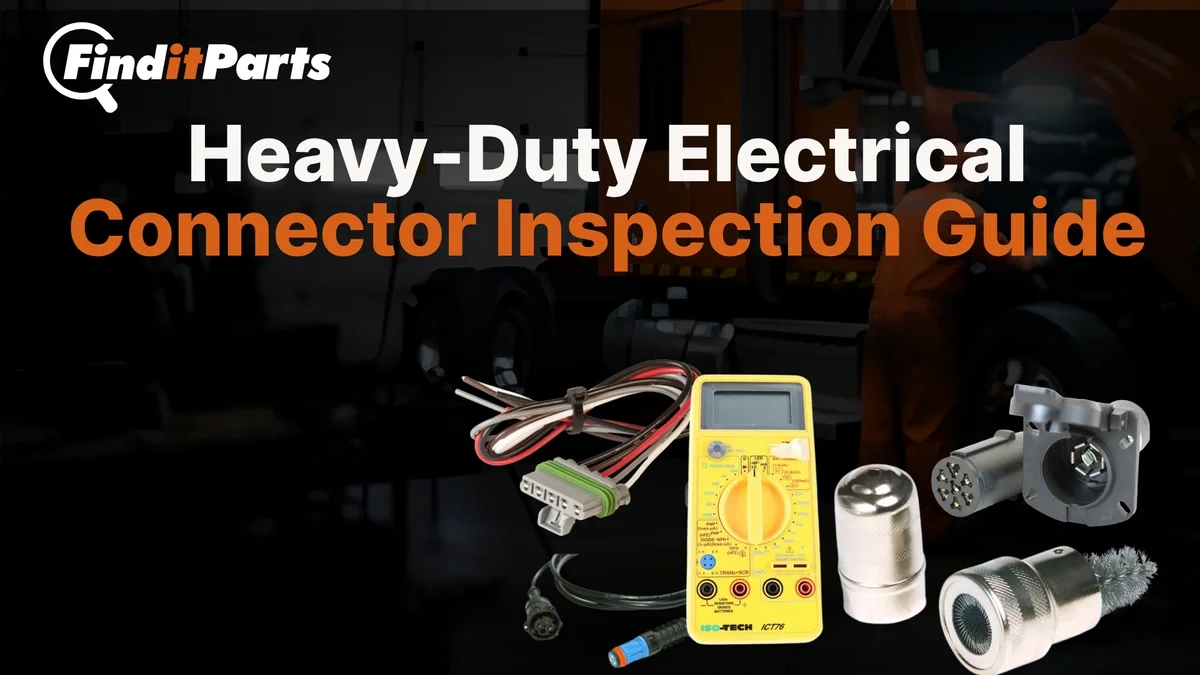Need help? We're here!
(888) 312-8812 Login SignupHeavy-Duty Electrical Connector Inspection Guide
October 29, 2025

Introduction
When you’re troubleshooting electrical issues on a heavy-duty truck, the last thing you want is to rip apart every wire and harness looking for the problem. The truth is, many electrical failures start small—bad connectors, weak crimps, or a little corrosion that slowly eats away at the contact. If left unchecked, that minor glitch turns into a dead headlight, trailer light violation, or worse, a truck stuck at the yard instead of rolling down the highway.
Doing routine electrical connector inspections doesn’t take much time, but it can save you a load of trouble. Staying ahead of loose, dirty, or damaged connectors improves the chances your electrical systems stay solid, from brake lights to battery feeds. You don’t need to be an electrician to spot issues early, but you do need to know what to look for, where to look, and how to keep those connections tight.
Understand Your Heavy-Duty Electrical Connectors
No matter how simple the job seems, electrical connectors play a big role in keeping heavy-duty trucks road-ready. These connectors serve as joints between wires, systems, and components. They link power, lighting, communication, and safety systems throughout the truck and trailer.
Here are a few types you’re most likely to find:
- 7-Way Round Connectors: These are standard trailer plugs, handling brake lights, turn signals, tail lights, electric brakes, reverse lights, and ground connections.
- Deutsch-Style Sealed Connectors: Common in engine compartments and control modules, built to resist vibration and seal out moisture and dirt.
- Weather Pack and Metri-Pack: Useful for exposed systems. These have tight-fitting seals and are designed to install and remove with minimal tools.
- Battery Terminal Connectors: Heavy-duty lugs or posts used to hook power cables to the battery and electrical distribution systems.
- ABS Diagnostic Connectors: Found on trucks equipped with ABS systems. They are essential for troubleshooting ABS modules or wheel speed sensors.
Each serves a unique job. When one of them is loose, damaged, or dirty, you’re asking for trouble. Even a mildly corroded trailer connector pin could mean intermittent brake lights—something that can get flagged during an inspection or cause a bigger problem.
The most efficient time to check your connectors is during planned preventive maintenance. But you should also take a look when strange electrical problems pop up. Don’t make the common mistake of tearing through harnesses or pulling relays. Start simple and check the connectors first.
Step-By-Step Inspection Process
You don’t need a garage full of diagnostics equipment to spot a bad connector. You just need a sharp eye, steady hands, and a methodical approach. Here’s how to go about it.
1. Do a Visual Check
- Look for cracked housings, melted plastic, exposed wires, or broken clips.
- Move the connectors to check for wiggle or loose fits.
- Inspect terminal pins closely. If you see white or green buildup, it usually means corrosion.
2. Clean the Connectors
- Use a terminal brush or an electrical contact cleaner spray.
- Skip the grease for now, it traps grime.
- Once clean, apply a light coating of electrical contact lubricant to ward off future corrosion.
3. Test with a Multimeter
- Measure for voltage drops or bad continuity from one side of the connector to the other.
- Set the multimeter to look for continuity when tracking flow between circuits.
- Flag connectors that read low voltage or give erratic results.
4. Reconnect and Secure
- Make sure connectors are fully seated and clipped into place.
- Replace any bad retainers or cracked housings.
- Check that wiring looms leading to the connectors are secured with zip ties or harness clips.
If something looks off—oxidation, a bent pin, looseness—don’t ignore it. An oddball connection might be the thing that leaves a truck in the yard instead of on the route. Having a few spare sealed connectors, battery lugs, or replacement trailer plugs on hand can cut down repair delays. Just make sure you always double-check the fitment and wire layout before committing to a replacement.
Common Problems With Electrical Connectors and How to Handle Them
Heavy-duty connectors are built tough, but they still wear out. Between heat, water, salt, vibration, and general use, they take a beating. Here’s what tends to go wrong the most—and how to deal with it.
- Corrosion at Pins or Terminals
Moisture and salt are the biggest causes. White or green deposits are your warning signs. Use contact cleaner and terminal brushes to scrub them clean. If corrosion is deep, pop in a new connector.
- Loose Connections
Over time, plastic fatigues and internal clips may lose grip. If the plug disconnects easily or wobbles, it’s time to re-pin or replace. Symptoms like flickering lights or sensor glitches often mean a loose contact.
- Melted or Cracked Housing
A short circuit or an overloaded wire can cause plastic to melt or crack. Water gets inside and makes things worse. Disconnect the bad unit immediately and inspect the wire ends before moving forward.
- Pulled Wires or Exposed Conductors
Wrong connector angles or poor strain relief can pull conductors out of their shells. If you see bare copper strands, you’re on borrowed time. Shrink tubing can help for minor damage. Bigger issues call for full replacement.
- Damaged Locking Tabs
Small as they are, locking tabs keep everything secure. A broken tab can lead to a loose plug. If the connection doesn’t click in firmly, consider it unreliable. Replace it instead of risking intermittent failure.
Keeping your truck running without headaches sometimes comes down to carrying a few spares. A standard terminal connector, a sealed Metri-Pack, or a fresh battery lug can turn a major repair into a quick swap. Just match the gauge, terminal pattern, and pin count and you’ll be back on the move.
Routine Maintenance Tips for Long-Term Connector Health
Prevention is the easy part—if you make it a habit. Here are some proven best practices to keep those electrical connectors working the way they should:
- Make inspections part of oil change or alignment visits. With things already disassembled, you save time.
- Apply dielectric grease to connector interiors to hold off corrosion.
- Never let connectors lie on the shop floor during disassembly. Gravel and dust do silent damage.
- Secure wiring with clips or zip ties to reduce stress pulling on the plug.
- Double-check alignment before reconnecting. Crooked pins can ruin connectors fast.
- Store spare parts in foam-lined cases, not tossed in a drawer. Misaligned pins or pressed parts get damaged quickly.
Keep the routine tools close—terminal brushes, multimeter, dielectric grease, and quality replacements. A basic go-kit can help mobile repairs go faster and ensure no corners get cut when time is tight.
Stay Road-Ready With Smart, Simple Checks
Good electrical connectors hide in plain sight. The better the maintenance, the less you’ll notice them doing their job—which is exactly what you want. Bad connections create weak grounds, dim lights, no-starts, glitchy sensors, and ticking clocks. Fixing it early means fewer surprise delays and a lot less stress.
Use every maintenance opportunity to check the small things. Clean plug points, wiggle harnesses, check voltage continuity. A few extra minutes spent at the shop bench beats chasing ghosts in the wiring when you’re loaded and behind schedule.
The benefit of keeping your connectors tight and clean may not splash across the dash, but it shows up in uptime, smooth diagnostics, and trucks actually making their rounds. A well-sealed, properly seated connection can often mean the difference between a smooth haul and a late delivery.
Routine inspections let you spot small issues before they become problems. They stop breakdowns, warnings, and costly guesswork. In between inspections, make sure your parts are heavy-duty grade, your connectors are sealed, and your wiring is secured.
Spending a few minutes here can save you hours down the road. Keep it clean, keep it steady, and keep rolling.
Ensure your fleet stays on the road by keeping up with regular inspections and maintenance of your heavy-duty electrical connectors. By addressing potential issues early, you save time and avoid costly breakdowns. Trust FinditParts Inc. to help you maintain efficiency with reliable parts right at your fingertips.



